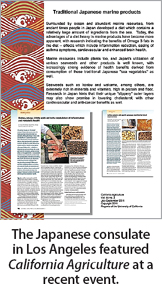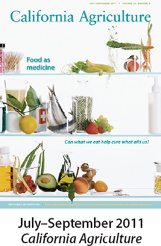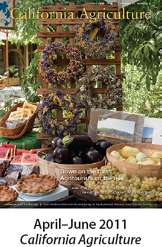All Issues
Letters
Publication Information
California Agriculture 65(4):179-180.
Published October 01, 2011
PDF | Citation | Permissions
Full text
RSVP
WHAT DO YOU THINK?
The editorial staff of California Agriculture welcomes your letters, comments and suggestions. Please write to us at: 1301 S. 46th St., Building 478-MC 3580, Richmond, CA 94804, or calag@ucdavis.edu. Include your full name and address. Letters may be edited for space and clarity.
Consulate features healthy Japanese foods
The recent articles on food ingredients — some of which play a big role in Japanese cuisine — are very timely (“Food as medicine,” July–September 2011), and have been of interest to attendees at several consulate events with a “healthy foods” component. Some Japanese foods, such as soy, miso and green tea, have shown indications of positive health effects, with many of these points covered in your articles.
Our first event was a kick-off reception to a U.S.-Japan conference on inflammation, diabetes and cancers for more than a hundred researchers from Cedars-Sinai, UCLA, Japan and the City of Hope (which hosted the conference). At this reception, we displayed your articles and made available full copies. Many researchers at the event have long been engaged in studying the health effects of soy, etc., and appreciated the linkage between positive health indications and traditional Japanese dietary components. Your articles kicked off many interesting discussions, and we appreciate your allowing us to incorporate them into our displays.
Your journal often uncovers interesting trends and research in California, and personally I've considered it a very rich resource for 20 plus years.
Brian Swords
Advisor, Economic Affairs
Consulate General of Japan
Los Angeles
Is grape juice healthy, too?
Re: “Food as Medicine” (July–September 2011). Red wine is considered good for us! What about Concord grape juice (nonfermented)? Has it similar benefits as a medicine or any benefits as a medicine? I am 93, and have been drinking it for years.
George Peabody
Placerville
UC Davis nutrition professors Carl A. Keen and Robert Rucker (emeritus) respond: Concord grape juice does contain substances with important health benefits, includingflavonoids and related substances that may function in cell signaling or the modulation of reactive oxidants important to health and even blood flow. However, we must be careful when making direct comparisons to the health-related attributes of other berries, juices and fermented products, such as wine. We note that you have lived for more than nine decades; one can surmise that you have made some prudent dietary and environmental decisions. With respect to the consumption of nonfermented grape juice or wine, both have the capacity to contribute in a positive manner to the complex milieu we define as a healthful life.
For the authors' full response, with references, go to: http://ucanr.org/u.cfm?id=23
Fritz photos at UC Berkeley
Barbara Fritz, whose father Emanuel Fritz was featured in “Scientists discover redwoods resiliency in Fritz's Wonder Plot” (April–June 2011), visited the UC Berkeley library recently, with her niece and other relatives.
They came to see the Fritz-Metcalf Photo Collection, which was given to the Forestry Library, now part of the Marian Koshland Bioscience and Natural Resources Library. The photos will be displayed on a future website. I printed out a copy of the California Agriculture article and introduced them to Elliott Smith, who helped identify a key photograph for the “Wonder Plot” article.
Barbara Fritz spoke of her father's work in the redwoods and of her childhood trips with her father to Forestry Camp in the the 1920s (Camp Califorest Sugar Pine, in Meadow Valley).
Norma Kobzina
Marian Koshland Bioscience and Natural Resources Library
UC Berkeley, www.lib.berkeley.edu/BIOS
Expensive East Coast agritourism
Re: “California agritourism operations and their economic potential are growing,” by Rilla et al. (April–June 2011). I am really shocked the farms in California don't charge for many events and programs. Out here they do, to the point that it costs way more to pick apples yourself than to buy them at the farmers market (which is in turn more expensive than the grocery store). It's a fun day out; but I think the prices here are offensive.
Michelle De Remer
New York, NY
Biomass fuels California power plants
The July–September 2011 online article on switchgrass (“Switchgrass is a promising, high-yielding crop for California biofuel” by Pedroso et al.; see page E168) correctly notes that demand for ethanol in California is expected to increase in the future. A related blog post ( http://ucanr.org/blogs/blogcore/postdetail.cfm?postnum=5487 ) discussed some of the policy drivers behind the desire to increase the production and use of cellulosic ethanol. The article implied that there are significant technical, economic and logistical challenges in converting ligno-cellulosic feedstocks such as switchgrass into ethanol at a commercial scale.
However, California already has a well-developed biomass-to-energy industry based on proven and deployed technology. California has approximately 30 operational biomass-to-electricity facilities, the most of any state, with 600 to 650 megawatts of capacity. Electricity from biomass comprises approximately 2% of the electricity used in California. The industry provides a disposal option for urban waste wood; woody biomass from fuels reduction and forest restoration; and agricultural residuals such as orchard removals, trimmings and nutshells.
The industry is currently in a state of flux due to differing power sales contracts and the fact that wider environmental benefits are not accounted for in the price of electricity. A 1999 National Renewable Energy Laboratory study put the value for the environmental services provided by biomass-to-electricity at 10 cents per kilowatt hour.
Developing new forms of bioenergy for the future is important, but society and decisionmakers should also understand and value the benefits delivered by the existing industry. To see current biomass power plants in California, go to: http://ucanr.org/BiomassPower .
Gareth J. Mayhead
Woody Biomass Technology and Marketing
Center for Forestry, UC Berkeley









